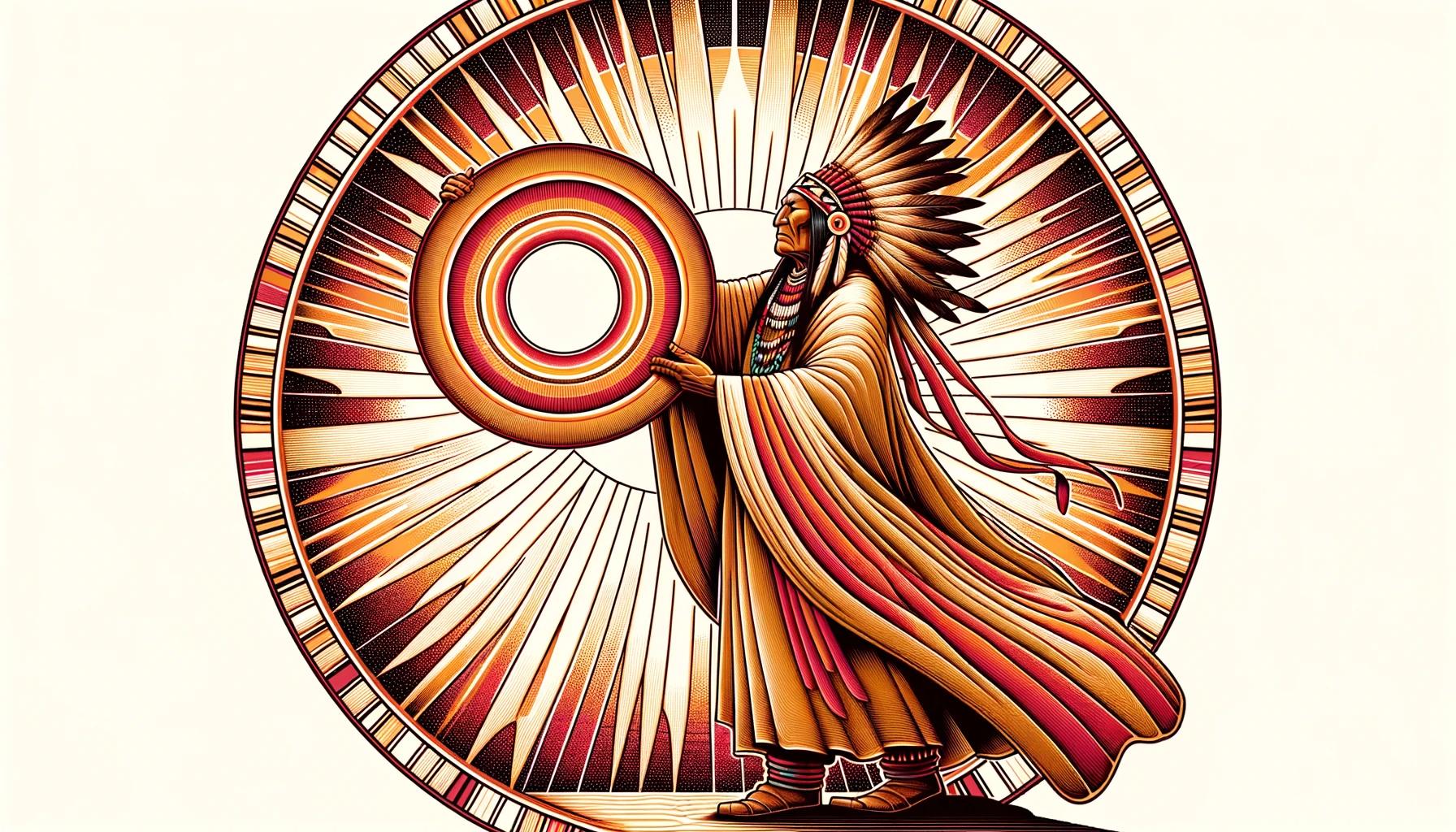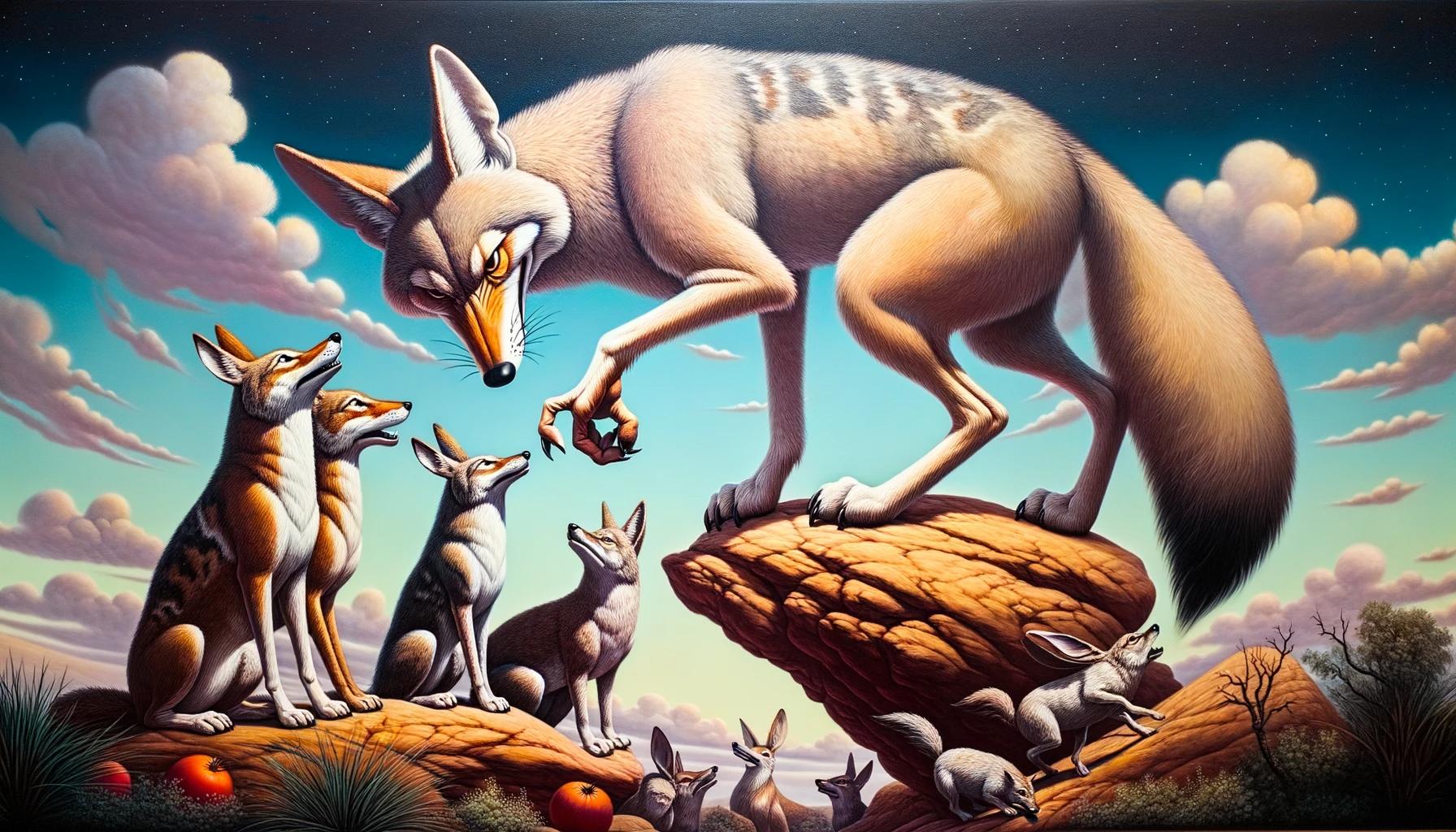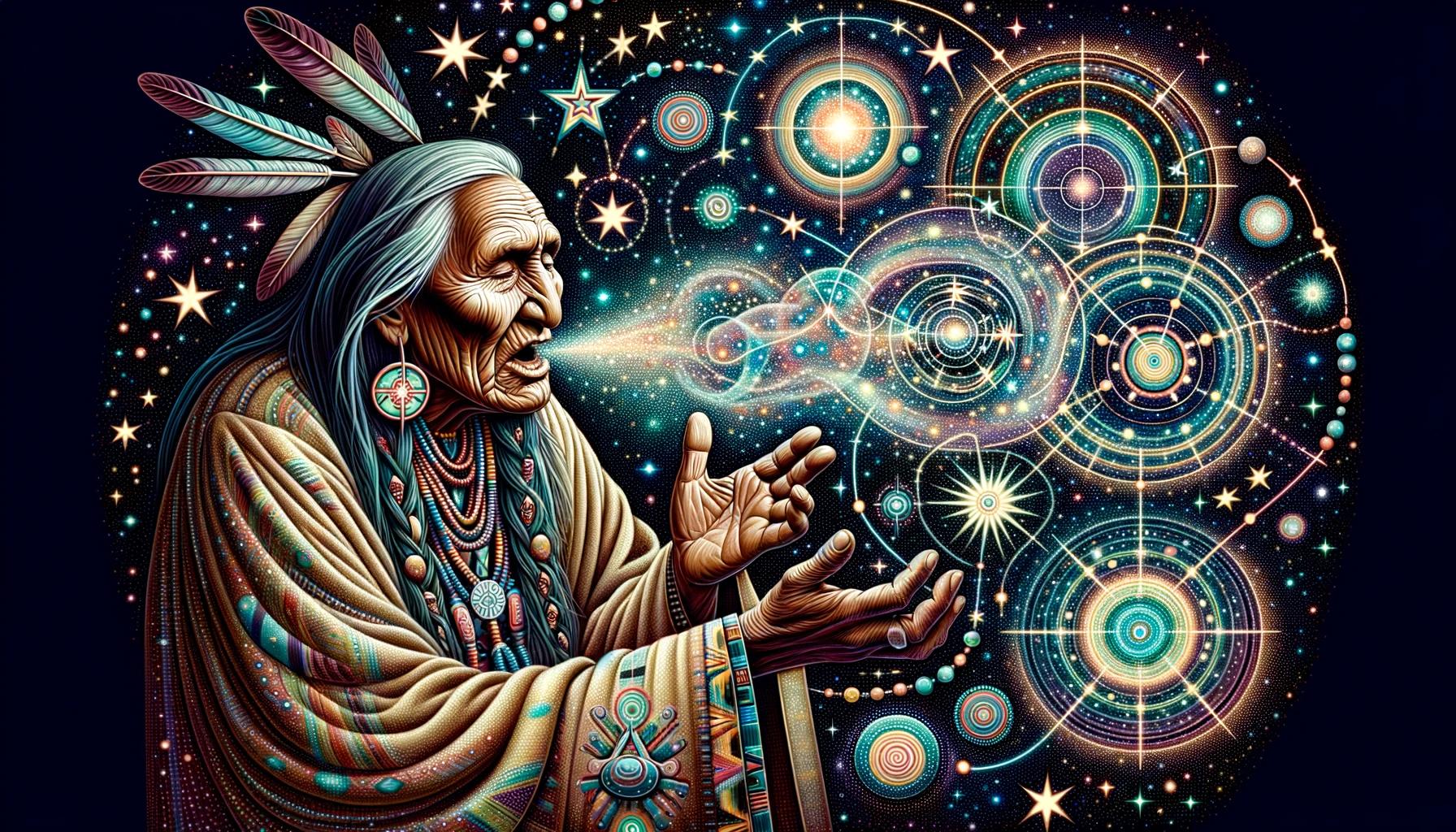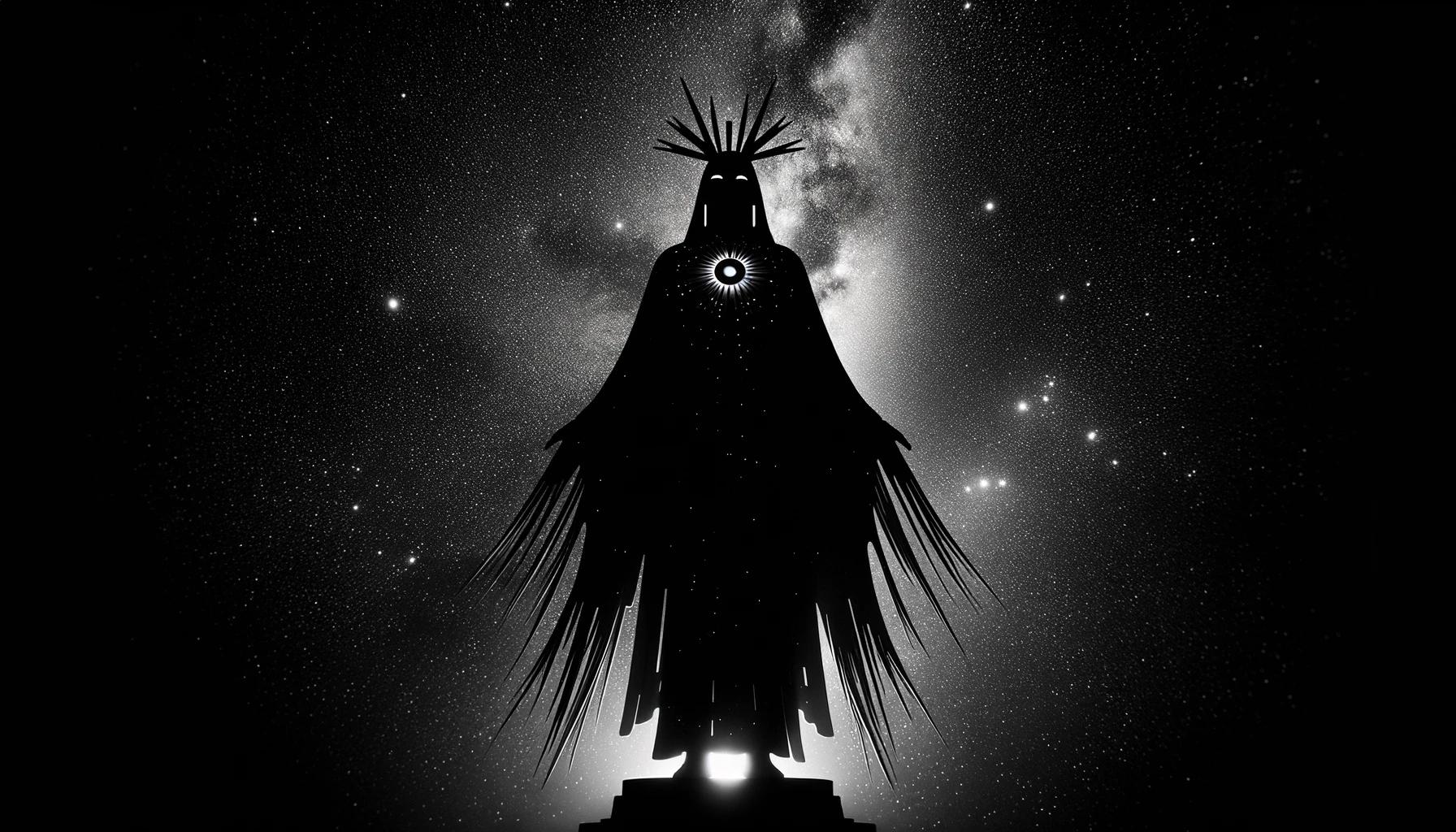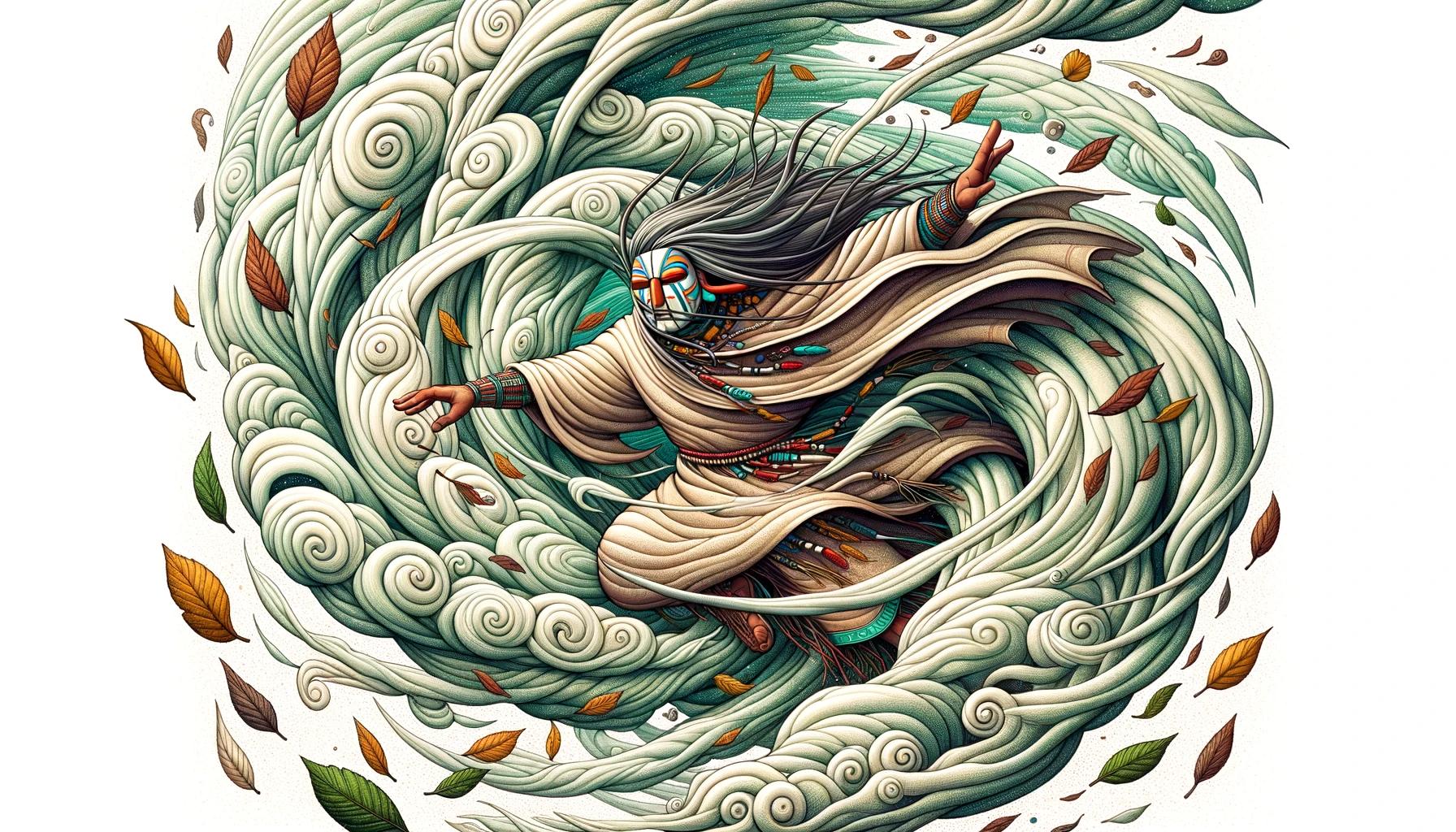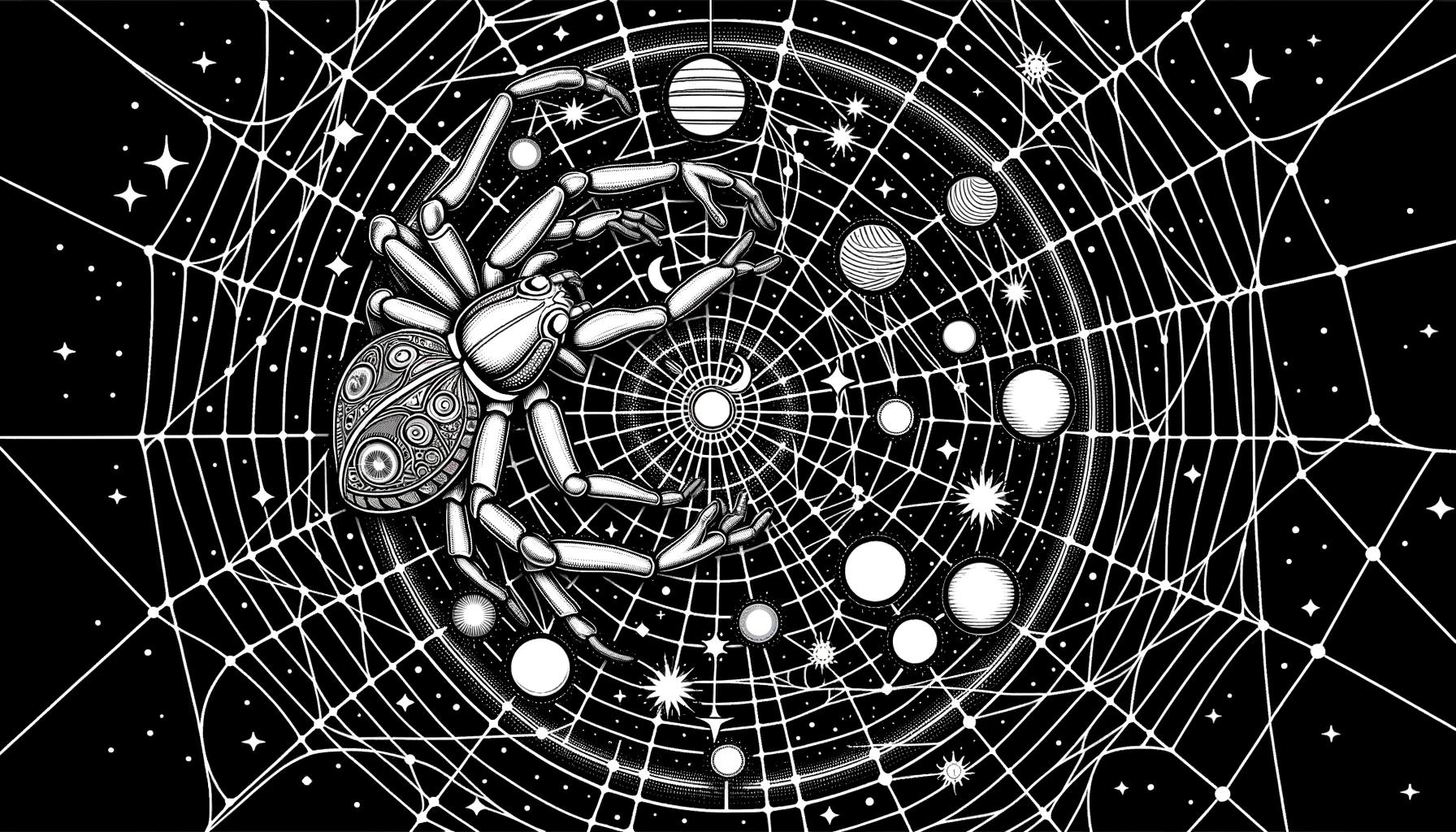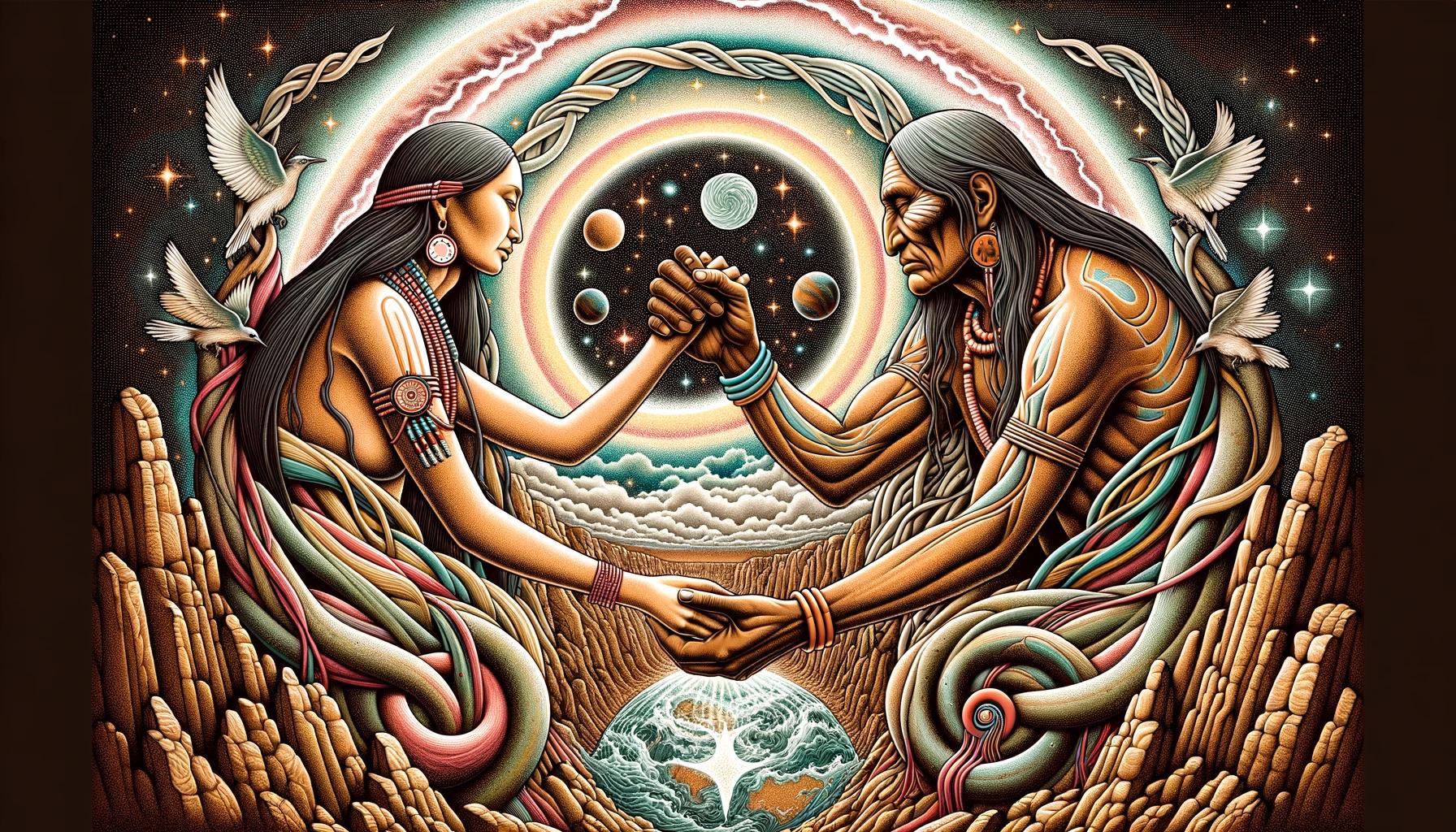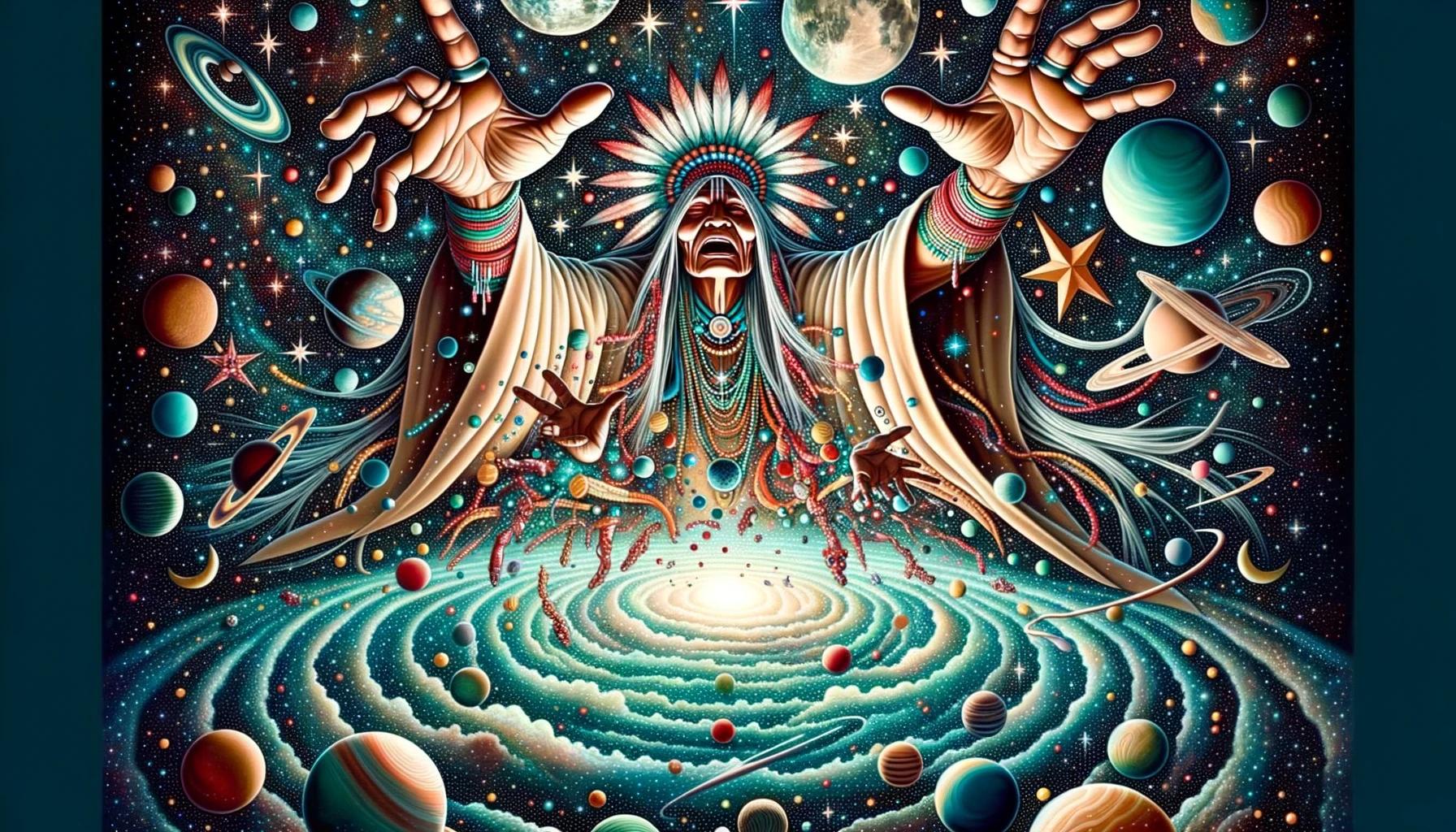Navajo Sun Bearer: Exploring the Sacred Mythology of the Southwest
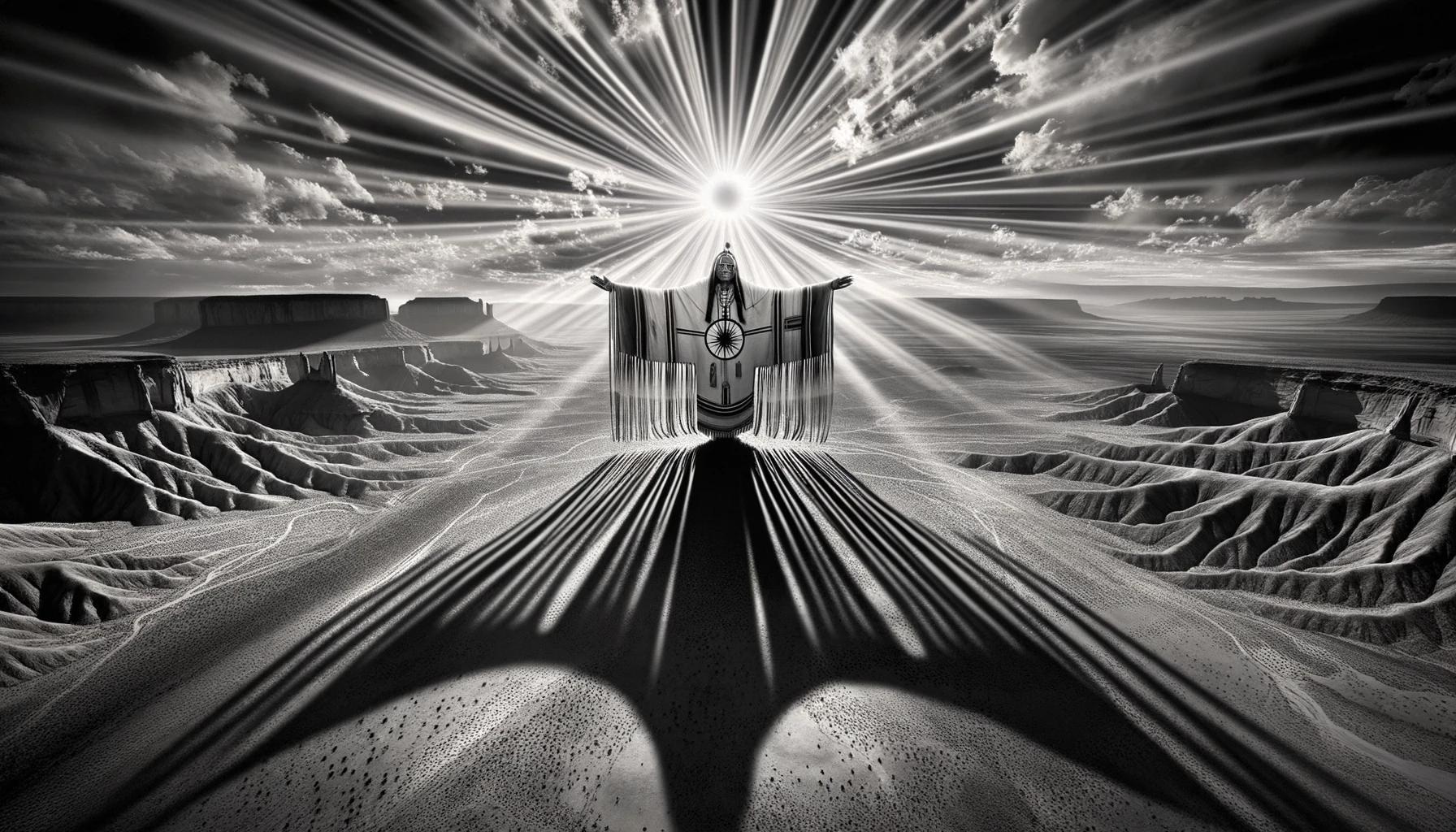
Navajo Sun Bearer is a significant figure in Navajo mythology. Known as Tsohanoai, this sacred being carries the sun across the sky every day. Depicted as a blue disk with eyes, mouth, and sometimes horns, Tsohanoai is also represented as a person in sand paintings.
He is recognized to have a wife, Changing Woman, and multiple illegitimate children. In one instance, Changing Woman’s sons, known as the Hero Twins, face challenges set by Tsohanoai in his home.
This article explores the symbolism, relationships, and cultural aspects related to Navajo Sun Bearer and delves into Navajo rituals and healing practices.
Exploring Navajo Mythology
The mythology of the Navajo people holds great significance within their culture, offering insights into their beliefs, values, and traditions. Through the exploration of Navajo mythology, we can gain a deeper understanding of their spiritual practices and worldview.
The Importance of Navajo Mythology
Navajo mythology plays a vital role in the cultural identity of the Navajo people. It serves as a means of passing down ancestral knowledge, preserving their history, and providing guidance for daily life.
The stories and myths woven into their traditions carry moral lessons, teach respect for nature, and emphasize the interconnectedness of all things.
Navajo Sun Bearer: Tsohanoai
One prominent figure in Navajo mythology is the Navajo Sun Bearer, known as Tsohanoai. Tsohanoai is a sacred being responsible for carrying the sun across the sky each day. Depicted as a blue disk with eyes, a mouth, and sometimes horns, Tsohanoai symbolizes the life-giving power of the sun and its significance in Navajo cosmology.
Through the exploration of Tsohanoai’s role and symbolism, we can delve into the complex narratives and rituals surrounding the Navajo Sun Bearer. By understanding Tsohanoai’s place within Navajo mythology, we can gain insights into the Navajo people’s profound spiritual connection with the natural world and their reverence for celestial forces.
Symbolism and Depiction of Navajo Sun Bearer
In Navajo mythology, the symbolism associated with the Navajo Sun Bearer, Tsohanoai, holds significant cultural importance. Represented as a blue disk with eyes and a mouth, the visual depiction carries deep meaning and spiritual significance for the Navajo people.
The Blue Disk with Eyes and Mouth
The blue disk, symbolizing the sun, represents the powerful celestial entity carried by Tsohanoai through the sky. The eyes and mouth depicted on the disk signify the divine nature and life-giving energy attributed to the sun in Navajo cosmology.
The eyes are believed to oversee the world and watch over the Navajo people, while the mouth represents the life-giving breath that sustains all living beings.
Representations of Tsohanoai
Tsohanoai is often portrayed as a sacred figure with horns, emphasizing the connection to the natural and spiritual realms. While the blue disk depiction is prevalent, Tsohanoai can also be represented as a person in sand paintings, displaying the Navajo reverence for the natural elements and their artistic expressions.
The varying representations of Tsohanoai serve to capture different aspects of the deity’s power and presence, highlighting the multifaceted nature of Navajo Sun Bearer mythology.
In delving into the symbolism and depictions of the Navajo Sun Bearer, we gain insight into the spiritual and cultural significance that Tsohanoai holds within the Navajo mythology.
These representations convey the reverence for the sun and its life-giving energy, while also showcasing the artistic expressions of the Navajo people.
The Divine Relationships of Navajo Sun Bearer
The Navajo Sun Bearer, Tsohanoai, is not only a powerful figure in Navajo mythology but also has significant relationships that contribute to the cultural and spiritual fabric of the Navajo people.
These divine connections shed light on the complex nature of Tsohanoai and his role in Navajo cosmology.
Changing Woman: Tsohanoai’s Wife
One of the most crucial relationships of the Navajo Sun Bearer is with Changing Woman, also known as Estsanatlehi. Changing Woman is Tsohanoai’s wife and symbolizes the cyclical nature of existence.
As the embodiment of fertility, change, and renewal, she plays a vital role in Navajo creation stories and rituals.
Illegitimate Children and Legitimization Trials
The Navajo Sun Bearer, known to have relationships with numerous other women, has many illegitimate children. These children are only recognized as legitimate when they successfully complete a challenging task or trial.
This reaffirms the Navajo belief in the importance of perseverance, determination, and overcoming adversity to prove one’s worthiness.
Legitimization trials serve as rites of passage for Tsohanoai’s children. These tasks can vary, testing the individual’s physical, mental, and spiritual strength.
By completing these trials set forth by the Navajo Sun Bearer, the children demonstrate their readiness to embrace their heritage and fulfill their destiny within Navajo society.
Such trials often involve facing the Navajo Sun Bearer himself, presenting an opportunity for personal growth and transformation.
The trials also reinforce the values of dedication, courage, and commitment within Navajo cultural practices.
Through the divine relationships tied to the Navajo Sun Bearer, the Navajo people express their interconnectedness with celestial entities and the significance of familial bonds, perseverance, and cultural identity.
The Hero Twins and Their Encounter with Navajo Sun Bearer
The Navajo Sun Bearer, Tsohanoai, presented a formidable challenge to the Hero Twins in their legendary encounter. This pivotal event in Navajo mythology tested the courage, skills, and resourcefulness of the Hero Twins, shaping their destinies and solidifying their place in Navajo lore.
Challenge from Tsohanoai
When the Hero Twins, sons of Changing Woman, crossed paths with Tsohanoai, the Navajo Sun Bearer, they faced a powerful adversary. Tsohanoai, with his celestial role of carrying the sun across the sky, commanded authority and demanded respect.
He cast a formidable shadow, challenging the Hero Twins to prove their worth through a series of tasks.
Tasks Faced by the Hero Twins
As the Hero Twins embarked on their encounter with Tsohanoai, they confronted a series of arduous tasks. These challenges demanded not only physical strength but also ingenuity and resilience. In their quest to prove themselves, the Hero Twins demonstrated their mastery over nature, their unwavering determination, and their unwavering commitment to their people.
The tasks set by Tsohanoai were diverse and demanding. From navigating treacherous paths through sacred mountains to outwitting formidable mythological creatures, the Hero Twins displayed their cunning, bravery, and strategic thinking.
They harnessed the wisdom passed down to them by their ancestors and used it to overcome each obstacle, growing stronger with each success.
The trials faced by the Hero Twins were as much about self-discovery as they were about earning Tsohanoai’s recognition.
Through their unwavering perseverance and the divine guidance they received, the Hero Twins not only secured legitimacy as children of Changing Woman but also ensured the prosperity and protection of their people, symbolizing the Navajo resilience and their indomitable spirit.
Cultural Aspects Related to Navajo Sun Bearer
Navajo Art: Baskets, Jewelry, Pottery, and Tapestry
The Navajo people have a rich artistic tradition that encompasses various forms such as baskets, jewelry, pottery, and tapestry. Navajo baskets are meticulously crafted using traditional techniques and often feature intricate designs inspired by nature, geometric patterns, and Navajo symbols.
Navajo jewelry, renowned for its exquisite silverwork and vibrant gemstones, holds deep cultural and spiritual significance. Navajo pottery showcases the skillful craftsmanship of creating vessels adorned with mesmerizing patterns and earth-toned colors.
Additionally, Navajo tapestries beautifully depict stories, symbols, and the natural world using vibrant threads.
Influence of Other Tribes: Hopi, Santo Domingo, and Zuni
The Navajo people have a rich cultural exchange with neighboring tribes such as the Hopi, Santo Domingo, and Zuni. This intertribal influence has resulted in the fusion of artistic styles and the sharing of cultural practices.
The Hopi, known for their intricate pottery and katsina dolls, have influenced Navajo pottery and art. The Santo Domingo Pueblo artisans have had an impact on Navajo jewelry, particularly in the use of shell and turquoise.
The Zuni tribe’s expertise in intricate stone inlay work can also be seen in Navajo jewelry designs. This cross-cultural exchange has enriched the artistic traditions of all involved.
Navajo Mythological Creatures and Deities
Navajo mythology is replete with a diverse array of creatures and deities that play significant roles in the tribe’s cosmology.
These entities embody various natural elements and spiritual forces. Examples include Yei, powerful supernatural beings depicted in sand paintings; Chindi, malevolent spirits believed to cause illness and misfortune; and Haashchʼééłtiʼí, the Talking God, who features prominently in Navajo ceremonies.
Each of these mythological beings holds distinct symbolism and cultural significance within the Navajo belief system.
Navajo Daily Life and Natural Environment
The Navajo people’s daily life is deeply intertwined with their natural environment. They have a profound respect for the land and its resources. The sacred mountains hold great spiritual significance and serve as directional guides for ceremonies and everyday life.
The Navajo rely on traditional agricultural practices, with maize being a staple crop. Other sacred plants, such as sacred tobacco and sage, are used in rituals and ceremonies. The Navajo relationship with the environment is rooted in harmony and balance, emphasizing sustainability and reverence for the natural world.
Rituals, Ceremonies, and Healing Practices in Navajo Culture
Within Navajo culture, rituals, ceremonies, and healing practices hold immense significance. They serve as important means to connect with the spiritual realm, maintain balance, and promote well-being. These practices encompass various aspects of Navajo life, including medicine, symbolism, and community engagement.
Navajo Medicine and Healing Traditions
Navajo medicine is deeply rooted in the belief that the mind, body, and spirit are interconnected. Traditional healers, known as Medicine Men or Women, possess extensive knowledge of herbal remedies, ceremonies, and rituals.
They combine these elements to facilitate physical, emotional, and spiritual healing.
Herbs and plants play a crucial role in Navajo medicine. They are believed to carry inherent healing properties and are used in the form of teas, poultices, or smudging ceremonies.
By harnessing the power of these natural elements, the healer aims to restore balance and harmony within the individual.
Navajo healing practices often incorporate chants, songs, and prayers to invoke the assistance of spiritual beings.
These rituals create a sacred space where the healer establishes a connection with the divine forces and channels their energy towards healing the patient.
Symbolism in Navajo Ceremonies
- Hózhǫ́ǫ́ǫ́gį̨̨̨į̨̨̨́ (Beauty Way) Ceremony: This important Navajo ritual focuses on restoring balance, harmony, and beauty in all aspects of life. Through the use of sandpaintings, symbolic gestures, and prayers, participants seek to achieve hózhǫ́ǫ́ǫ́ (harmony) within themselves and the world around them.
- Blessingway Ceremony: The Blessingway Ceremony is a significant rite of passage that celebrates major life transitions, such as birth, marriage, or entrance into adulthood.
It aims to provide spiritual protection and guidance during these crucial phases. Symbolic objects and rituals, including the creation of a corn pollen path, are integral to this ceremony.
- Sweatlodge Ceremony: Sweatlodge ceremonies are purifying rituals that promote physical and spiritual cleansing.
Participants enter a tightly enclosed structure, representing the womb of Mother Earth, and endure intense heat and steam. This process is believed to foster purification, renewal, and spiritual transformation.
Throughout these ceremonies, symbolism is woven into every detail, from the colors used to the specific actions and words spoken.
Each symbol holds deep cultural and spiritual meaning, conveying messages of interconnectedness, balance, and the power of the divine.
The rituals, ceremonies, and healing practices of the Navajo people are rich in tradition and continue to play a vital role in their cultural and spiritual identity.
They provide a profound framework for maintaining harmony and well-being within individuals, communities, and the natural world.
.











